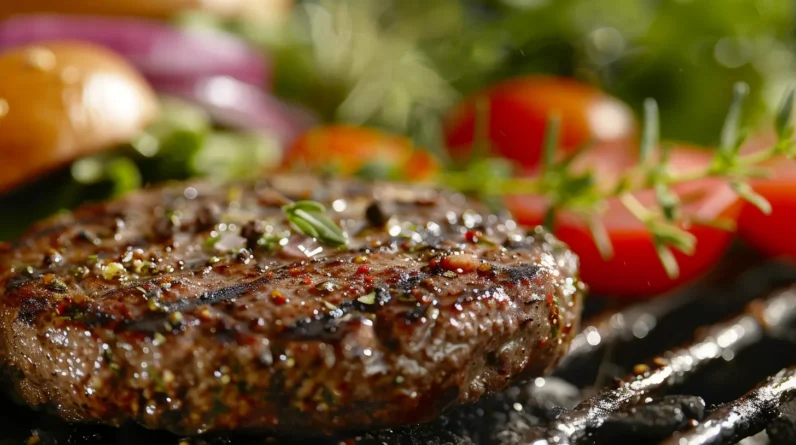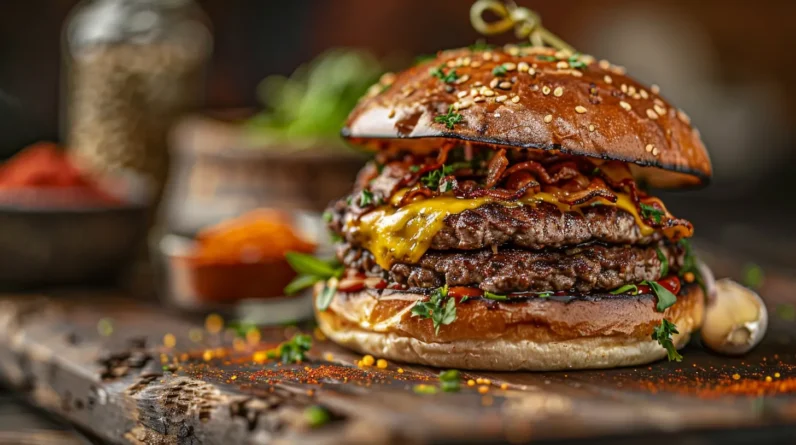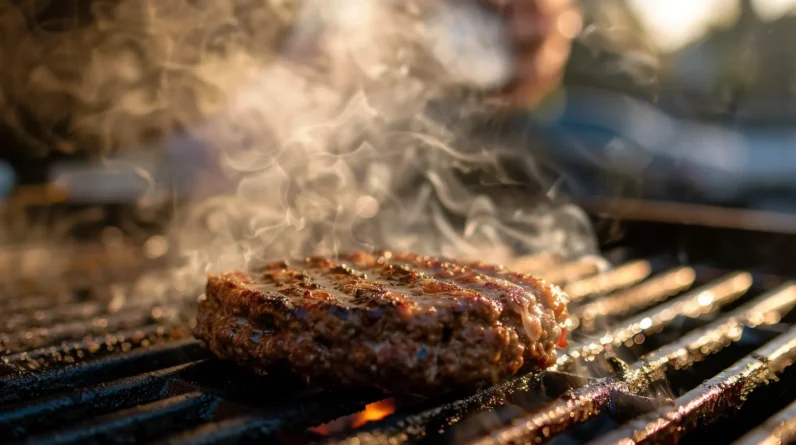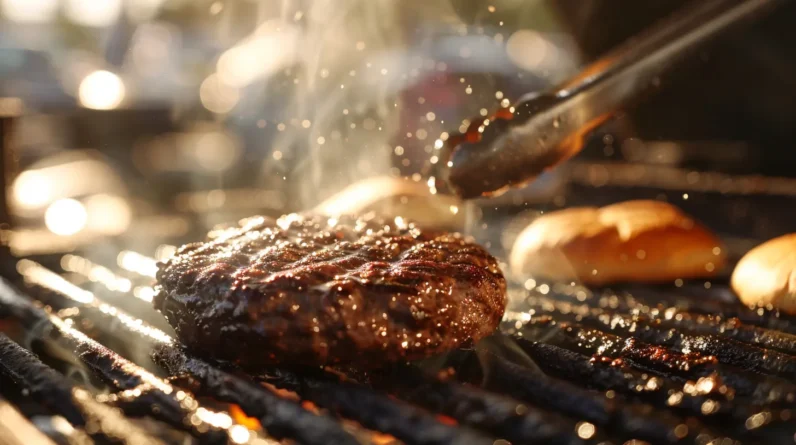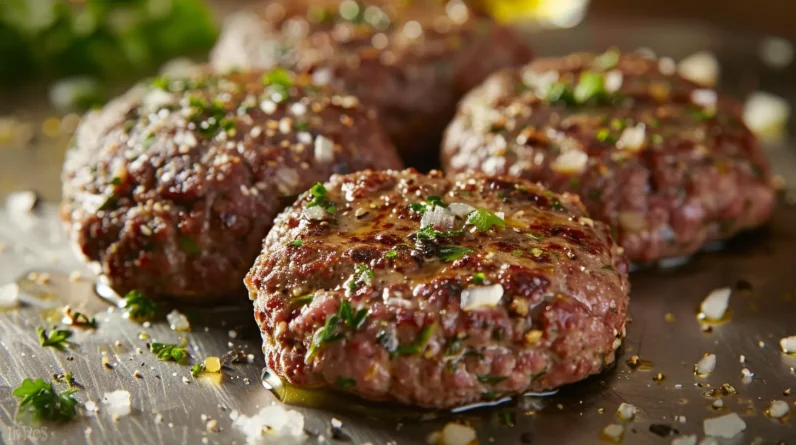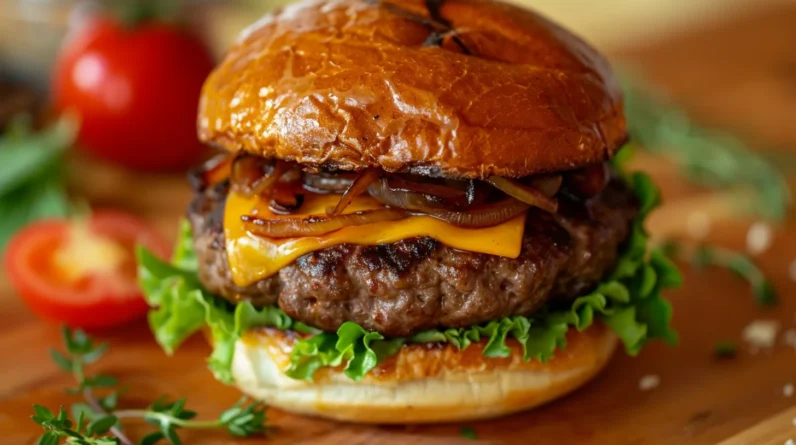
The science of grilling perfect burgers relies on precise temperature control and expert moisture management. We’ll establish dual heat zones (450-500°F for searing, 350-375°F for controlled cooking) and select meat with an ideal 80/20 lean-to-fat ratio to guarantee juiciness. By triggering the Maillard reaction through high-heat searing and maintaining proper moisture through dimpling and single-flip technique, we’ll achieve that coveted mahogany crust while preserving internal juiciness. Monitoring internal temperature with a digital thermometer guarantees consistent results, pulling at 135°F for medium-rare perfection. These fundamental principles reveal the gateway to mastering festive burger excellence.
Heat Zones and Temperature Control
Setting up proper heat zones is critical for achieving the perfect burger consistency. We’ll establish two distinct zones on our grill: a high-heat zone (450-500°F) for searing and a medium-heat zone (350-375°F) for controlled cooking. For gas grills, we’re adjusting burners to create this differential. On charcoal grills, we’re banking coals heavily on one side.
We’re monitoring these zones using an infrared thermometer, ensuring precise temperature control throughout the cooking process. Our high-heat zone creates the Maillard reaction for ideal crust formation, while the medium zone lets us manage internal temperature progression without burning. When flare-ups occur, we’ll move patties to the medium zone, preventing char and maintaining even cooking. This dual-zone approach gives us complete control over both exterior caramelization and internal doneness.
The Perfect Protein-to-Fat Ratio
With our heat zones properly established, let’s examine the foundation of any great burger – its protein-to-fat ratio. For peak juiciness and flavor development, we’ll target a precise balance between lean meat and fat content. The ideal ratio falls between 75/25 and 80/20 (lean-to-fat), which provides sufficient fat for both moisture retention and flavor enhancement during the cooking process.
– 70/30 ratio produces overly greasy burgers with excessive shrinkage and flare-ups
– 75/25 ratio delivers maximum juiciness while maintaining structural integrity
– 80/20 ratio offers balanced flavor with moderate moisture retention
– 85/15 or leaner results in dry, dense patties lacking proper flavor development
We’ll select premium ground chuck for its ideal fat distribution and superior meat-to-collagen ratio, ensuring consistent results across multiple grill sessions.
Mastering the Maillard Effect
During the grilling process, achieving the perfect Maillard reaction transforms ordinary burgers into flavor-packed masterpieces. We’ll need to maintain a grill temperature between 375-450°F to trigger this vital chemical reaction between amino acids and sugars in the meat proteins.
Let’s make sure our burger patties are pat-dried before hitting the grill, as excess moisture inhibits proper browning. We’re aiming for direct, high heat to create that complex flavor development and appealing brown crust. The Maillard reaction begins around 285°F, but we’ll push higher to accelerate the process. Don’t flip the burgers repeatedly – give each side 3-4 minutes of uninterrupted contact with the grates. When we see the edges browning and juices starting to pool on top, that’s our cue for the first and only flip.
Moisture Management Methods
The perfect Maillard reaction works hand-in-hand with proper moisture control throughout the grilling process. We’ll manage moisture content strategically to achieve prime results while maintaining the burger’s succulence. By understanding moisture’s role, we’re controlling both surface evaporation and internal juiciness.
– Maintain 80/20 lean-to-fat ratio to guarantee adequate intramuscular moisture during cooking
– Salt patties 40 minutes before grilling to allow proteins to dissolve and re-absorb moisture
– Create a shallow dimple in the center to prevent dome-shaped burgers and moisture loss
– Monitor internal temperature with an instant-read thermometer, pulling at 135°F for medium-rare
Using these moisture management techniques, we’re creating the ideal conditions for both proper browning and juice retention. The key is balancing surface moisture evaporation for prime Maillard development while preserving internal moisture content.
Timing Your Perfect Flip
Mastering burger-flip timing represents a critical factor in achieving ideal browning and internal temperature control. We’ll want to flip our burgers only once, approximately 3-4 minutes into cooking on a properly preheated grill (450-500°F). This single-flip method guarantees peak Maillard reaction development and prevents moisture loss through excessive handling.
When we notice small beads of moisture emerging on the raw surface and the edges beginning to turn gray (roughly 60% up the sides), that’s our signal. The first side should show a deep mahogany color with clear grill marks. After flipping, we’ll cook for another 3-4 minutes for medium-rare (130-135°F internal temperature), adjusting time by 1-minute increments for desired doneness. A precise digital thermometer remains essential for temperature verification.
Conclusion
We’ve dissected the molecular choreography of burger grilling down to its empirical foundations, yet let’s acknowledge that even with our precisely calibrated heat zones and scientifically optimized fat ratios, we’re still fundamentally playing with fire and dead cow. Nevertheless, our methodologically sound approach elevates this primitive cooking ritual into a reproducible protocol that consistently yields superior results. When executed properly, we’re not just grilling—we’re conducting delicious science.


